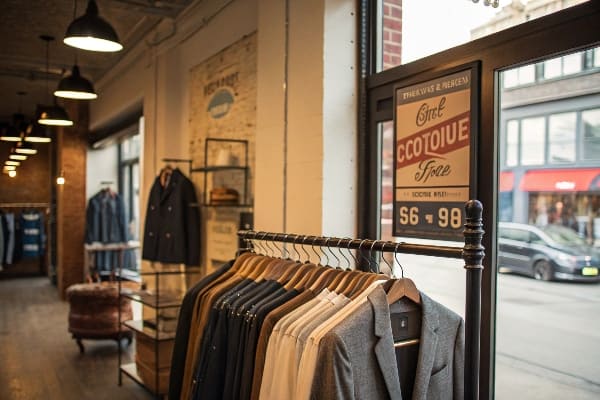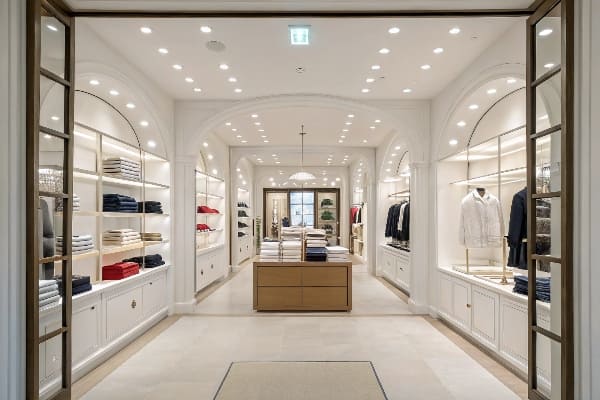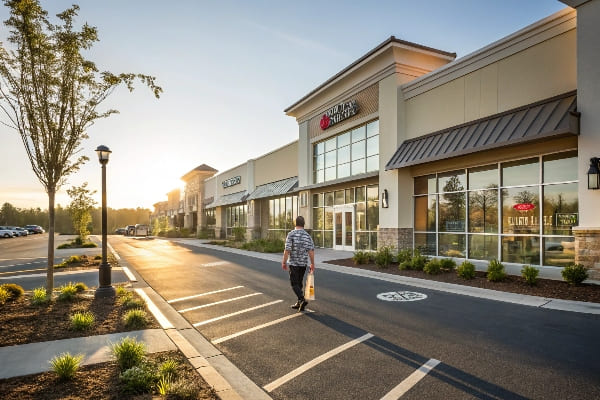I used to think my store looked great until a client pointed out three empty hooks and a faded display. That moment cost me a big re-order.
Seeing the floor as a first-time visitor highlights blind spots, pushes quick fixes, and drives higher sales because every detail speaks before you open your mouth.

If you keep reading, I will show you the exact steps I use on my cardboard-display production line and in our showroom to keep buyers engaged from the door to the desk.
How do you approach customers on the sales floor?
Last month a buyer walked in with a frown. I felt the pressure to speak first, yet I paused and watched where his eyes landed.
Approach with a smile, a three-second pause for the customer to orient, and a simple open question that invites conversation without cornering them.

Reading the Room
I divide the first minute into three quick checks:
| Step | What I Notice | My Action |
|---|---|---|
| One | Eye line | Stand in that sight path so I look helpful, not intrusive. |
| Two | Hand movement | If they touch a display, comment on that product. |
| Three | Foot speed | Slow pace means they browse; fast pace means direct need. |
Choosing Words
I keep language short. “Welcome in. What caught your eye?” feels lighter than, “Can I help you?” That open line lets them lead. If they answer, I build on the word they use most. When a chain-store buyer says “strength,” I point to the eight-kilogram load test we ran on the very stand they are holding.
Managing Space
A clear aisle lets me walk beside, not in front. I stand an arm’s length away, angled at forty-five degrees. That prevents a face-off posture. I learned this from watching security footage; customers stayed longer when I respected that bubble.
Turning Interest into Trust
The second minute is for proof. I hand them a mini sample, same flute, same print. Physical contact builds belief faster than talk. Then I share a quick story: “Barnett Outdoors cut setup time by half with this header lock.” Stories anchor facts.
I end with a soft check-in: “Shall I show you the stress test?” If they nod, we move deeper; if not, they browse alone. That rhythm keeps pressure low yet opens doors for bigger discussions.
What is the first thing you do when a customer visits your store?
When the bell rings, I do not rush forward. I step back, breathe, and scan the floor for anything out of place.
Reset the environment first—clear clutter, straighten displays, and ensure the opening sight line is clean—before greeting the visitor.

The Quick Environment Audit
| Checkpoint | Why It Matters | Time Spent |
|---|---|---|
| Entrance mat1 | A dirty mat signals neglect. | 5 seconds |
| Primary display | First focal point drives perception of quality. | 10 seconds |
| Lighting2 | Broken bulbs kill color accuracy. | 5 seconds |
I treat this like a pilot’s pre-flight. A crooked header steals authority faster than a wrong price tag. If a sample looks worn, I swap it. That habit started after a Canadian chain rejected a project because the sample edge was frayed.
Greeting After the Fix
Only when the scene looks perfect do I walk up with a calm tone. The delay feels counter-intuitive, yet customers read body language; a rushed greeting shouts desperation. A composed approach tells them I run an ordered process from design to shipping.
Linking to Production
My showroom mirrors our factory line: neat lanes, labeled racks, clear safety signs. Consistency sells trust3. Buyers guess how you make things by how you show things. So my first action—resetting the scene—whispers that their mass order will also look crisp.
Where is the sales floor?
I used to think the sales floor was only the tiled space between door and register. Then a repeat buyer told me my loading dock convinced him to double his order.
The sales floor is every customer-visible area—from parking lot and website to shipping bay—because each touchpoint forms one continuous buying experience.

Mapping the Real Floor
| Zone | Customer Interaction | Often Ignored Risk |
|---|---|---|
| Online landing page | First research step | Slow load time4 |
| Parking or reception | Sets comfort level | Poor signage |
| Showroom | Core pitch area | Outdated samples5 |
| Prototype bench | Proof of capability | Messy tools |
| Packing area | Trust in delivery6 | Weak carton |
Removing Gaps
I walk the full path monthly, phone in hand, filming each segment. Last video showed a dusty extinguisher by the dock gate. Fixing that small detail won praise from a safety-focused retail chain.
Digital Mirrors Physical
Our Alibaba page now shows live production clips. That makes the virtual floor feel as concrete as the showroom. When buyers land on the page, they already sense our process, so in-person meetings start at a higher trust level.
Maintaining this extended floor forces my team to see through client eyes at every step. It also cuts complaints; if packing looks sloppy online, we tighten it before the next audit request comes in.
What is the best way to approach a customer when they enter a store?
I used to open with a product pitch. Many walked away. Then I learned to start with the customer’s purpose, not my product.
Approach by aligning with their goal—ask what project they’re working on, listen fully, then link one clear benefit of your solution to their stated need.

Steps to Align
| Phase | Key Action | Words I Use |
|---|---|---|
| Listen | Let them speak first | “What brings you in today?” |
| Echo | Reflect their goal | “You’re launching a spring line.” |
| Relate | Share quick success case | “We helped a sports brand hit a March deadline with flat-packed stands.” |
| Offer | Present single next step | “Would you like a sample you can test in your lab?” |
Story in Practice
A UK franchise owner said he feared color shift between displays and brochures. I repeated, “Color match is vital for your brand,” then showed our spectro report with Delta E under 27. That simple echo built rapport quickly.
Non-Verbal Layer
I angle my torso slightly away, which feels less confrontational. Hands visible, palms open. Voice at a lower volume than theirs. These signals create a safe space for honest concerns, which surface real objections early.
Closing Without Pressure
After addressing the need, I give two options: deeper demo or self-guided walk8. Choice empowers them. About sixty percent pick the demo; the rest still leave with a positive impression and often return through email within a week.
How to approach customers in sales examples?
Theory means little without real scenes. I collect tiny wins and failures from daily work and review them with my team every Friday.
Use real scenarios—busy rush, slow browse, group visit—to rehearse flexible greetings that adapt tone, pace, and product focus in seconds.

Scenario Playbook
1. The Fast-Paced Buyer
He checks his watch twice before the door shuts. I skip small talk and ask, “Time target for your visit?” When he says, “Ten minutes,” I pull a pre-made bundle: design sheet, load test, price grid. We finish in eight. He smiles because I respected his clock.
2. The Quiet Researcher
She walks slowly, touches samples, says little. I match her pace, stand two steps away, and narrate only what she looks at. When she strokes the print, I comment, “That’s soy-based ink, safe for food displays.” She nods, takes a photo, and later emails for a quote.
3. The Group of Three
Mixed roles walk in: owner, designer, logistics head. I greet the owner first, then invite the designer to the color booth, and guide the logistics head to the stacking test. Splitting attention by role shows respect and uses time well.
| Scenario | Primary Need | Core Tactic |
|---|---|---|
| Fast-paced | Speed | Pre-bundled info |
| Quiet researcher | Safety | Low-key narration |
| Group visit | Role clarity | Parallel demos |
4. The Skeptic with Bad Past
He starts with, “Last supplier sent weak stands.” I acknowledge the pain, show our burst-test certificate9, and offer to break a sample on the spot. The act satisfies him more than data. He orders a small run as a test.
5. The Repeat Buyer
David from Barnett Outdoors walks in. I greet him by name, mention his last crossbow launch date, and show a mock-up for his next line without him asking. Anticipation secures reorders and reinforces partnership.
These examples remind my team that approach is not one-size-fits-all. By practicing, we respond in real time, keep anxiety low, and convert intent into orders.
Conclusion
See your space like a visitor, prepare your stage before you speak, match each greeting to the person, and the floor will start selling before you say a word.
A clean entrance mat is crucial for making a positive first impression and signaling professionalism. Explore this link to understand its impact better. ↩
Proper lighting is essential for showcasing products accurately. Discover how lighting influences customer perception and sales. ↩
Consistency in presentation builds trust with customers. Learn more about how it affects buyer confidence and decision-making. ↩
Understanding the effects of slow load times can help improve your online presence and customer satisfaction. ↩
Exploring this topic can provide insights into maintaining a modern and appealing showroom environment. ↩
Gaining insights on delivery trust can enhance your logistics and customer satisfaction strategies. ↩
Learn how spectro reports and Delta E measurements ensure color accuracy in branding and marketing materials. ↩
Explore the advantages of different presentation styles to better engage potential clients and enhance their experience. ↩
Learn about the significance of burst-test certificates in ensuring product reliability and customer confidence. ↩

